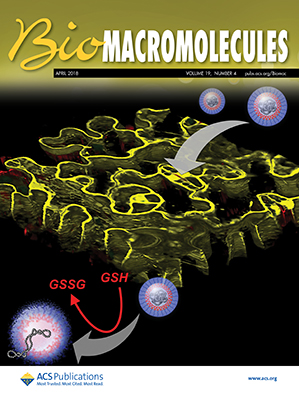Effect of Distribution of Substitution on Marine Biodegradability for Paramylon Acetate and Cellulose Acetate
IF 5.5
2区 化学
Q1 BIOCHEMISTRY & MOLECULAR BIOLOGY
引用次数: 0
Abstract
Paramylon acetate and cellulose acetate with different degrees and distributions of substituents were synthesized by two different methods, de-esterification from triesters with NaOH treatment and direct esterification. Paramylon and cellulose acetate obtained by de-esterification exhibited a lower degree of substitution (DS) at C6 and a higher DS at C2 position. All of the acetate samples with different DSs were thermoformable, producing transparent films. However, melt-pressed films obtained through de-esterification exhibited greater flexibility than those prepared via direct esterification. Simultaneously, biochemical oxygen demand (BOD) tests demonstrated that paramylon and cellulose acetate obtained by de-esterification show higher biodegradability than esterification ones with the same DS. This increased biodegradability may be attributed to the lower DS of the acetyl group on C6 for paramylon and cellulose acetate obtained by de-esterification. De-esterification with NaOH treatment was validated as an effective approach for producing polysaccharide esters with excellent mechanical properties and biodegradability for both paramylon and cellulose.
- Download: Download high-res image (118KB)
- Download: Download full-size image
取代分布对醋酸Paramylon和醋酸纤维素海洋生物降解性的影响。
采用NaOH法和直接酯化法分别合成了不同取代基程度和分布的醋酸丙酰胺和醋酸纤维素。脱酯化得到的丙酰胺和醋酸纤维素在C6位置的取代度较低,而在C2位置的取代度较高。所有具有不同DSs的醋酸盐样品都是热成型的,形成透明薄膜。然而,通过脱酯化得到的熔融压膜比直接酯化制备的膜具有更大的柔韧性。同时,生化需氧量(BOD)试验表明,脱酯化法得到的酰胺和醋酸纤维素的生物降解性优于相同DS的酯化法得到的酰胺和醋酸纤维素。这种生物可降解性的提高可能是由于通过脱酯化得到的paramylon和醋酸纤维素的C6上乙酰基的DS较低。NaOH脱酯化是一种有效的方法,可以制备具有优异力学性能和生物降解性的多糖酯。
本文章由计算机程序翻译,如有差异,请以英文原文为准。
求助全文
约1分钟内获得全文
求助全文
来源期刊

Biomacromolecules
化学-高分子科学
CiteScore
10.60
自引率
4.80%
发文量
417
审稿时长
1.6 months
期刊介绍:
Biomacromolecules is a leading forum for the dissemination of cutting-edge research at the interface of polymer science and biology. Submissions to Biomacromolecules should contain strong elements of innovation in terms of macromolecular design, synthesis and characterization, or in the application of polymer materials to biology and medicine.
Topics covered by Biomacromolecules include, but are not exclusively limited to: sustainable polymers, polymers based on natural and renewable resources, degradable polymers, polymer conjugates, polymeric drugs, polymers in biocatalysis, biomacromolecular assembly, biomimetic polymers, polymer-biomineral hybrids, biomimetic-polymer processing, polymer recycling, bioactive polymer surfaces, original polymer design for biomedical applications such as immunotherapy, drug delivery, gene delivery, antimicrobial applications, diagnostic imaging and biosensing, polymers in tissue engineering and regenerative medicine, polymeric scaffolds and hydrogels for cell culture and delivery.
 求助内容:
求助内容: 应助结果提醒方式:
应助结果提醒方式:


